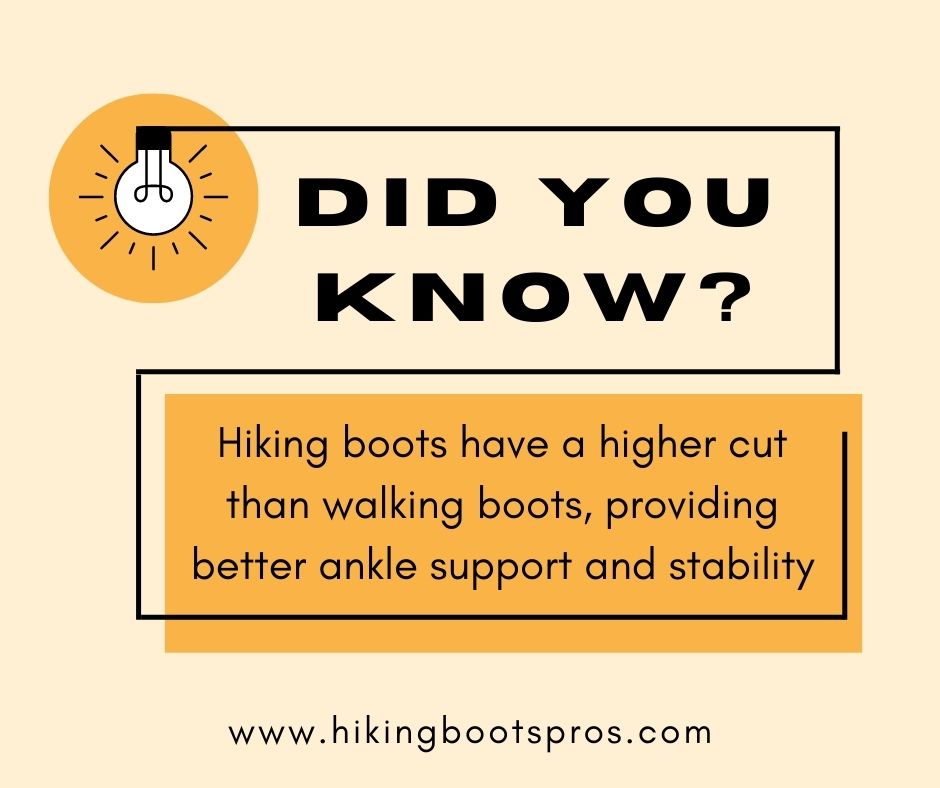Last updated on May 8th, 2023
Hiking and walking are two activities that require proper footwear to ensure maximum comfort and protection. While walking boots and hiking boots may seem similar, there are significant differences between them.
In this blog post, we will explore the differences between hiking boots and walking boots, their features, and which is best for outdoor activities. We will also answer the question, “Can walking boots be used for hiking?” and discuss the features you should look for in both types of boots.
What Is the Difference Between Hiking Boots and Walking Boots?
When it comes to outdoor activities such as hiking or walking, the choice between hiking boots and walking boots is often a question of personal preference.
Both hiking and walking boots serve the same purpose, which is to protect your feet and provide comfort while you’re out on the trail. However, there are significant differences between the two types of boots, and it’s important to understand these differences to choose the right footwear for your needs.
Hiking Boots:
Hiking boots are specifically designed for outdoor activities. These outdoor activities include hiking, backpacking, and mountaineering.
These boots are sturdy and supportive, designed to provide stability on uneven terrain. They are typically made with a thick sole and a higher cut, which provides ankle support, and are often made of waterproof materials.
Hiking boots come in a variety of styles, from lightweight options suitable for day hikes to heavier, more rugged boots for multi-day backpacking trips.
Walking Boots:
Walking boots, on the other hand, are designed for everyday wear and shorter walks on even terrain. These boots are lightweight, flexible, and comfortable, with a lower cut than hiking boots.
Walking boots are often made with breathable materials to ensure your feet stay cool and comfortable. They usually have a softer sole than hiking boots, which makes them more comfortable for walking on pavement or flat trails.
Can Walking Boots Be Used for Hiking?
Walking boots are a popular choice of footwear for everyday activities, such as walking and light exercise.
If you are planning a short and easy hike on a flat surface, walking boots can be a suitable option. However, many people wonder if walking boots can be used for hiking as well. The answer is not straightforward, as it depends on the following factors.
The Type of Hiking
The type of hiking also plays a role in determining whether walking boots are suitable. For short hikes on easy terrain, walking boots may be sufficient.
However, for longer hikes, steep ascents, or challenging terrain, hiking boots are recommended. Hiking boots provide better support, traction, and protection from the elements, making them ideal for more rugged terrain and unpredictable weather conditions.
Personal Comfort and Fit
Personal comfort and fit are crucial when selecting footwear for hiking. While walking boots may be comfortable for short walks, they may not provide enough support and protection for longer hikes.
Hiking boots are specifically designed to provide maximum comfort and support, allowing hikers to traverse rough terrain with ease. It is essential to choose hiking boots that fit correctly and provide adequate support for your feet and ankles.
What Features Should I Look For in Hiking Boots vs. Walking Boots?
Choosing the right footwear for your outdoor activities can make a significant difference in your comfort and performance.
Hiking boots and walking boots are two types of footwear designed for different purposes, and it’s crucial to understand their differences to make an informed decision. Here are some features to look for when choosing between hiking boots and walking boots.
Sole Design
The sole design of hiking boots is typically thicker and more rigid than that of walking boots. This design provides better support and protection for your feet when hiking on rough and rocky terrain.
Walking boots, on the other hand, has a thinner sole that offers more flexibility and allows for a better ground feel and stability.
Ankle Support

Hiking boots have a higher cut than walking boots, providing better ankle support and stability. This feature is particularly crucial when hiking on steep and uneven terrain. Walking boots, on the other hand, have a lower cut, providing more freedom of movement and flexibility.
Water Resistance
Hiking boots are designed to withstand wet and muddy conditions, with features such as waterproof membranes and durable materials. Walking boots, on the other hand, may not offer the same level of water resistance.
Weight
Hiking boots tend to be heavier than walking boots, as they are designed to provide more support and protection for your feet. Walking boots are typically lighter, providing better comfort and flexibility for long walks.
Durability
Hiking boots are made with durable materials that can withstand the wear and tear of rough terrain. Walking boots may not offer the same level of durability, as they are designed for less demanding activities.
HAVE A LOOK AT: Are hiking boots the same as safety boots
Conclusion
In conclusion, choosing the right footwear is essential for outdoor activities. While hiking boots are more suitable for challenging terrains, walking boots are ideal for casual walks and light hikes on flat surfaces.
It’s essential to choose boots that provide ankle support, durability, traction, and waterproofing for hiking and flexibility, cushioning, breathability, and lightweight design for walking. Always prioritize the features that align with your intended activity.
FAQs
Yes, hiking boots are more durable than walking boots. They are made of sturdy materials to withstand harsh conditions and rough terrains.
Hiking boots are usually more expensive than walking boots. The added durability, ankle support, and traction features make hiking boots more expensive. Walking boots, on the other hand, are designed for comfort and ease of use, making them more affordable.

Tyler Looney is an avid hiking enthusiast and the author of HikingBootsPros.com, a website dedicated to providing helpful insights and advice on choosing the best hiking boots. His expertise and passion for hiking have made him a valuable resource for both beginner and experienced hikers alike.

